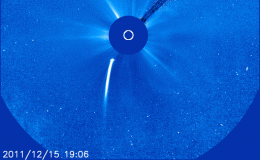Comet Lovejoy plunges into the sun and survives (w/ video)

Last week, an armada of spacecraft witnessed something that many experts thought impossible. Comet Lovejoy flew through the hot atmosphere of the sun and emerged intact.
"It's absolutely astounding," says Karl Battams of the Naval Research Lab in Washington DC. "I did not think the comet's icy core was big enough to survive plunging through the several million degree solar corona for close to an hour, but Comet Lovejoy is still with us."
The comet's close encounter was recorded by at least five spacecraft: NASA's Solar Dynamics Observatory and twin STEREO probes, Europe's Proba2 microsatellite, and the ESA/NASA Solar and Heliospheric Observatory. The most dramatic footage so far comes from SDO, which saw the comet go in and then come back out again.
In the SDO movies, the comet's tail wriggles wildly as the comet plunges through the sun's hot atmosphere only 120,000 km above the stellar surface. This could be a sign that the comet was buffeted by plasma waves coursing through the corona. Or perhaps the tail was bouncing back and forth off great magnetic loops known to permeate the sun's atmosphere. No one knows.
"This is all new," says Battams. "SDO is giving us our first look1 at comets travelling through the sun's atmosphere. How the two interact is cutting-edge research."
“The motions of the comet material in the sun’s magnetic field are just fascinating,” adds SDO project scientist Dean Pesnell of the Goddard Space Flight Center. “The abrupt changes in direction reminded me of how the solar wind affected the tail of Comet Encke in 2007.”
Comet Lovejoy was discovered on Dec. 2, 2011, by amateur astronomer Terry Lovejoy of Australia. Researchers quickly realized that the new find was a member of the Kreutz family of sungrazing comets. Named after the German astronomer Heinrich Kreutz, who first studied them, Kreutz sungrazers are fragments of a single giant comet that broke apart back in the 12th century (probably the Great Comet of 1106). Kreutz sungrazers are typically small (~10 meters wide) and numerous. The Solar and Heliospheric Observatory sees one falling into the sun every few days.
At the time of discovery, Comet Lovejoy appeared to be at least ten times larger than the usual Kreutz sungrazer, somewhere in the in the 100 to 200 meter range. In light of today's events, researchers are revising those numbers upward.
"I'd guess the comet's core must have been at least 500 meters in diameter; otherwise it couldn't have survived so much solar heating," says Matthew Knight. "A significant fraction of that mass would have been lost during the encounter. What's left is probably much smaller than the original comet."
SOHO and NASA's twin STEREO probes are monitoring the comet as it recedes from the sun. It is still very bright and should remain in range of the spacecrafts' cameras for several days to come. Researchers will be watching closely, because there a good chance for more surprises.
"There is still a possibility that Comet Lovejoy will start to fragment," continues Battams. "It’s been through a tremendously traumatic event; structurally, it could be extremely weak. On the other hand, it could hold itself together and disappear back into the recesses of the solar system."
"It's hard to say," agrees Knight. "There has been so little work on what happens to sungrazing comets after perihelion (closest approach). This continues to be fascinating.”
Source: Science@NASA



















